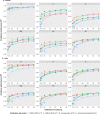Optimizing the procedure of grain nutrient predictions in barley via hyperspectral imaging
- PMID: 31697705
- PMCID: PMC6837513
- DOI: 10.1371/journal.pone.0224491
Optimizing the procedure of grain nutrient predictions in barley via hyperspectral imaging
Abstract
Hyperspectral imaging enables researchers and plant breeders to analyze various traits of interest like nutritional value in high throughput. In order to achieve this, the optimal design of a reliable calibration model, linking the measured spectra with the investigated traits, is necessary. In the present study we investigated the impact of different regression models, calibration set sizes and calibration set compositions on prediction performance. For this purpose, we analyzed concentrations of six globally relevant grain nutrients of the wild barley population HEB-YIELD as case study. The data comprised 1,593 plots, grown in 2015 and 2016 at the locations Dundee and Halle, which have been entirely analyzed through traditional laboratory methods and hyperspectral imaging. The results indicated that a linear regression model based on partial least squares outperformed neural networks in this particular data modelling task. There existed a positive relationship between the number of samples in a calibration model and prediction performance, with a local optimum at a calibration set size of ~40% of the total data. The inclusion of samples from several years and locations could clearly improve the predictions of the investigated nutrient traits at small calibration set sizes. It should be stated that the expansion of calibration models with additional samples is only useful as long as they are able to increase trait variability. Models obtained in a certain environment were only to a limited extent transferable to other environments. They should therefore be successively upgraded with new calibration data to enable a reliable prediction of the desired traits. The presented results will assist the design and conceptualization of future hyperspectral imaging projects in order to achieve reliable predictions. It will in general help to establish practical applications of hyperspectral imaging systems, for instance in plant breeding concepts.
Conflict of interest statement
The authors have declared that no competing interests exist.
Figures






References
-
- OECD-FAO Agricultural outlook 2017–2026. Special focus: Southeast Asia. Paris: OECD Publishing; 2017.
-
- McKevith B. Nutritional aspects of cereals. Nutr Bull. 2004; 29: 111–142. 10.1111/j.1467-3010.2004.00418.x - DOI
-
- Elleuch M, Bedigian D, Roiseux O, Besbes S, Blecker C, Attia H. Dietary fibre and fibre-rich by-products of food processing. Characterisation, technological functionality and commercial applications: A review. Food Chem. 2011; 124: 411–421. 10.1016/j.foodchem.2010.06.077 - DOI
-
- Gaudichon CC. Protein quality in human nutrition and contribution of cereals to protein intake. Nantes, France; 2015.
Publication types
MeSH terms
LinkOut - more resources
Full Text Sources

